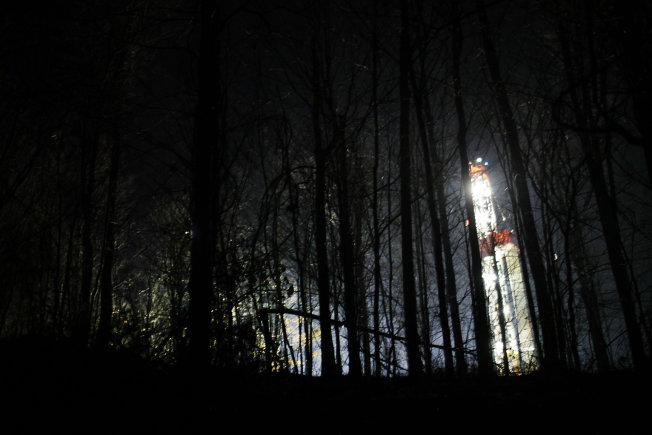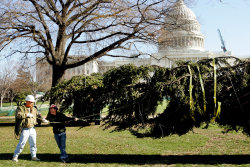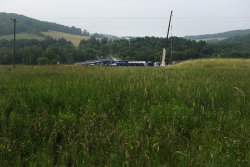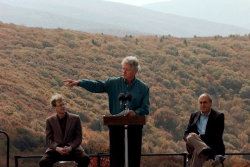Forest Service OKs Fracking in Forest Near Nation's Capital
Analysts say the decision has more to do with avoiding precedent than extracting oil and gas.

A fracking site lights up the woods in 2012 in Springville, Pa. The U.S. Forest Service says it will allow leases for fracking in Virginia's George Washington National Forest.
Oil rigs could one day join the treetops in George Washington National Forest south of the nation’s capital.
Despite protests from Virginia’s Democratic governor and environmental groups, the U.S. Forest Service announced this week it would make 177,000 acres – or about 17 percent – of the forest in Virginia available for leasing for horizontal drilling and hydraulic fracturing, or fracking.
The practice would be allowed on about 167,000 acres where there are existing private mineral rights – in other words, sites where people, groups or companies own whatever oil, gas and other minerals sit beneath the soil. It would also be allowed on another 10,000 acres that have already been leased to oil and gas firms.
Energy development will be prohibited in the rest of the 1.1 million-acre forest, which is home to mountain streams that provide the drinking water for hundreds of thousands of people in the Shenandoah Valley, as well as part of the drinking supply for more than 2 million people in the District of Columbia and northern Virginia.
"We think we've ended up in a much better place, which is we are allowing oil and gas drilling," Robert Bonnie, the U.S. Department of Agriculture's undersecretary for natural resources and environment, told The Associated Press.
"From a policy perspective, the Forest Service allows fracking on forest lands throughout the country. We didn't want to make a policy decision or change policy related to fracking. This decision is about where it's appropriate to do oil and gas leasing."
[READ: Obama's Latest Climate Goal With China]
The Forest Service is part of the Agriculture Department. Unlike in national parks, the Forest Service leases national forestland for oil and gas development.

The agency’s announcement this week reversed a draft decision from 2011, in which the Forest Service proposed barring unconventional oil and gas development across the entire forest – a move that would have amounted to a de facto ban on all energy development in the forest and sparked an outcry from oil and gas companies.
“The only economical oil and gas extraction in that area is horizontal drilling,” says Lowell Rothschild, an environmental litigator and senior counsel with the law firm Bracewell & Giuliani, who has focused on natural resource issues. “So yes, if you prohibit horizontal drilling, you prohibit...oil and gas energy development.”
Tuesday's decision, however, has less to do with actual energy development in the forest, which is expected to be minimal, than with avoiding a new precedent, Rothschild and other experts say – one that could invite costly lawsuits from energy companies fearful a blanket ban on oil and gas development could be instituted in other national forests, too.
“They threaded the needle,” Rothschild says. “This is a small portion of the forest – I don’t think it’s a particularly potentially productive area. It’s more of a policy issue.”
[ALSO: Tech, Not Oil Prices, Spurred $35 Billion Halliburton and Baker Hughes Merger]
The 177,000 acres opened by the decision sit atop a small sliver of the Marcellus Shale, a 600-mile underground formation of slate, limestone and sandstone that stretches from West Virginia to upstate New York.
The Marcellus is also one of the primary sources of the country's domestic energy boom of the past decade: All that rock holds huge deposits of oil and gas, which energy companies have been extracting through horizontal drilling and fracking, a process that involves injecting blasts of water, sand and chemicals underground to crack open the rock.
Scientists and environmental groups across the nation have voiced strong concerns about fracking. Studies have found the wells used to carry oil and gas above ground can be prone to failure, leeching toxic chemicals into drinking water supplies. Other research efforts have also found that drill and fracking sites, pipelines, wells and compressor stations can prove especially leaky, spewing methane – a potent greenhouse gas – and toxic compounds into the air.
[MORE: Toxic Chemicals and Carcinogens Skyrocket Near Fracking Sites, Study Says]
In Virginia and the nation’s capital, environmental groups voiced concern that fracking could poison the region’s drinking water supply.
“This technology is dangerous, it poses threats to air and health, and it shouldn’t be allowed in places where the drinking water of 3 million-plus people hangs in the balance,” says Alan Septoff, a spokesman for Earthworks, which opposed the revised management plan for the forest.
Other environmental advocates, however, welcomed the decision.
“There are unfortunately existing rights with regard to natural gas, but there will be no new gas development in the forest, and that’s good,” says Glen Besa, director of the Sierra Club's Virginia chapter.
Sarah Francisco, a senior attorney at the Southern Environmental Law Center, agrees.
“It achieves the objective of protecting this special
national forest from all the impacts of gas drilling and fracking,” she says, “particularly
the heavy industrial impacts that gas development would have on the national
forest and all of its existing uses and resources.”




